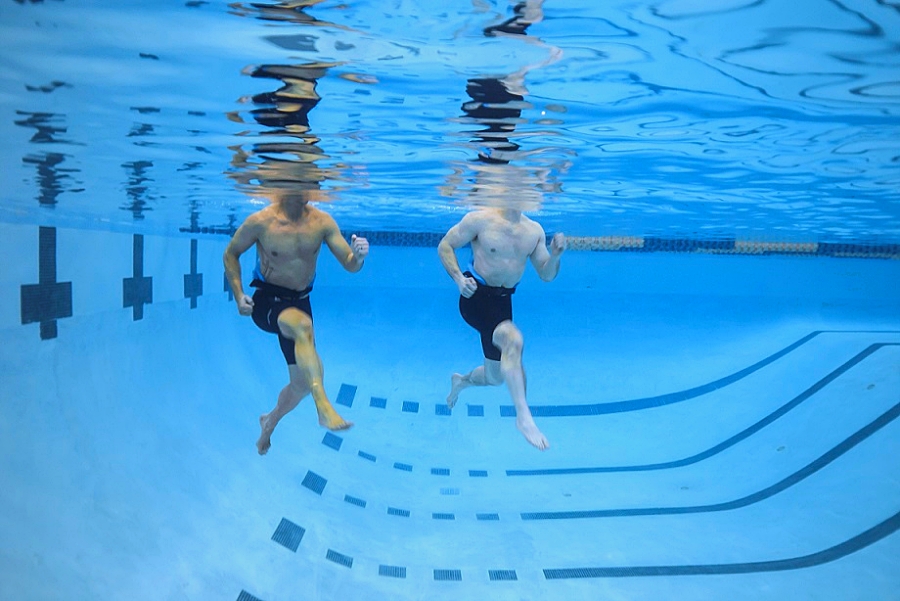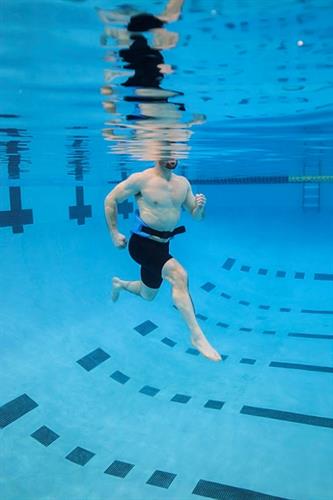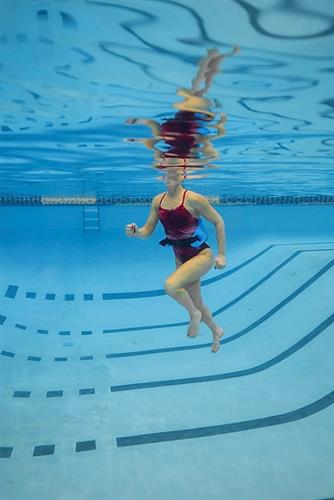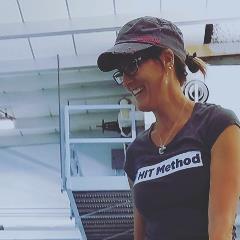Melis Edwards, MS, ACSM-EP® |
Sept.
3, 2019

Take Home Points:
1. Understanding that Aquatic Exercise is a viable training method for athletes.
2. Utilizing Aquatic Exercise could be a method to work with clients who have compromised
joints.
3. Aquatic Exercise can be used for both healthy and rehabilitating clients.
If you read the words Aquatic Exercise (AE), quickly ask yourself: What is the first image that pops into your head? Let me guess—older ladies splashing around in the shallow end of the pool, arms pumping above their shoulders out of the water. Was I right? I’d say about 90 percent of the people reading this would think of something similar to my description.
But this is not what I nor the growing percentage of the population think of. It isn’t to say that there isn’t a population which could be described in this manner; it is just that the vision of AE has been dramatically changing over the years. This new imagery will include volleyball teams jump training in shallow water or track teams performing deep water sprint drills. And to help this change are research or journal articles directed at AE (like in the July/August ACSM’s Health & Fitness Journal®, “Aquatic Exercise for Health: Probing the depths of HIIT for Cardiometabolic Training,” by Elizabeth Nagle, Mary Sanders, and Bruce Becker).
I have been working in this industry for more than 30 years, primarily focusing on deep water training (feet not touching the pool bottom; head out). A few years ago, my co-author (Kat Wight) and I decided to write a fitness manual on how to perform this type of training (Deep End of the Pool Workouts: No-Impact Interval Training and Strength Exercises, Ulysses Press) which described multiple deep water drills down to the details of specific hand positions to gain the most drag from the water density as possible.
The focus of the book wasn’t rehabilitation, but for A-HIIT (Aquatic High Intensity Interval Training) type of training. But oddly, when asked about the book or the training, again, the first thought these individuals had was of the original image mentioned earlier; not the second—of serious training.
Drs. Nagle, Sanders and Becker stated that water training is “still generally underutilized and often overlooked by populations who could benefit the most.” So, with that in mind, it is understandable that this form of exercise is rarely even considered for a trained, uninjured athlete.

...water training is “still generally underutilized and often overlooked by populations who could benefit the most.”
In my career teaching AE and land-based training and coaching, I have had the amazing opportunity to work with professional athletes; from hockey to football to tennis, as well as individuals most considered for AE. These athletes typically arrive in the waters due to specific injuries and have been prescribed water training to keep or ameliorate their fitness while in rehab. However, the excellent biproduct of this work was that these athletes learned that they could actually train for their sport in water as well.
Over the years I have seen every person, including athletes, feel stronger, fitter and faster once they are back in their regular land-based training. Water is a very unique training medium, allowing for little to no joint trauma, higher cardiac output (due to the hydrostatic pressure), increased blood flow and more.
What is excellent about working in both shallow and deep water is that from the coach's perspective, typically standing on the side of the pool (example in video below), every movement becomes essentially “highlighted.” This simply means that the coach can end up seeing even more weak areas on the athlete than just the original injury which had them come to the pool in the first place!
"...the coach can end up seeing even more weak areas on the athlete than just the original injury which had them come to the pool in the first place!"
This “vision” can be stronger for those of us working in the field longer, but moreover it is because as an AE coach, you can direct specific movement patterns to be performed slowly (remember there is viscosity and density of water which doesn’t happen on land) or quickly to watch the muscle/movement actions. This is very difficult to do on land without video equipment at hand.
And what would a coach look for precisely? Well, when in deep waters, muscle weakness, injuries and flexibility issues are highlighted dramatically. Recently, I had an opportunity to work with a professional athlete rehabilitating from a knee injury, but what I saw in the water was much more than what the athlete came to me with. By having the athlete perform one simple movement pattern, the Cross Country*, I saw additional weaknesses throughout his body. Had these weaknesses gone unchecked, and the “rehab” been performed only on the localized injury, they could have led to further injuries and compromised the athlete’s future performance.
(*This stroke has the person in the deep water, suspended and swinging their arms and legs counter to each other, and with limb efforts countering while having a moderate torso rotation to aid in increased workload. This is an open kinetic chain movement which requires use of both anterior and posterior muscle recruitment, especially through the abdominals, hips, shoulder/back rotation, down to even the dorsiflexion of the feet -see embedded video below for demonstration).
My belief has been the same for years; As trainers and coaches, we need to continually think outside the box when working with individuals of any abilities. But change is difficult. I think of when Yoga was first introduced to the NFL; originally joked about, but now a regular part of practice. I think of AE in the same way. I know that we are in a societal change when it comes to training; we must be able to accommodate the type of extreme competition so many people are seeking.
The long-term effects of many of these sports have already been seen in the physical therapists’ and orthopedic surgeons’ offices; and these effects will continue due to the increased popularity of these sports. Therefore, as coaches and trainers, we have a responsibility to encourage unconventional types of training modalities to help our clients be as healthy as possible.
My ultimate goal as an AE coach/trainer is for the variations of aquatic training to be embraced and regularly utilized by all populations; think global domination.
Well, a girl’s gotta dream, doesn’t she?
EXAMPLE WORKOUT:
Training in water is unique, and almost counterintuitive. To achieve an intense A-HIIT workout, keep in mind that the intensity comes from how hard you work AGAINST the water, not with it. Tiny, quick “dragless” movements will be much easier than larger movements. As described in the ACSM piece referenced earlier, you can drive your muscles and heart rate hard, but the water will aid in a quicker recovery (i.e., hydrostatic pressure).

"...the intensity comes from how hard you work AGAINST the water, not with it."
With that said, to control your heart rate, a floatation belt is used for any deep work. The flotation belt does not make the workout easier, it allows for heart rate control. Think of it this way: the more lean your athletes are, the less buoyant.
This example workout is a full body workout, which does focus on lower extremities; however, note that every movement made should be grounded in your abdominal/core; no limb movement happens without that engagement. This is the power of this open kinetic chain exercise. When not engaged, the exercises can appear easy. If they are easy, I will say the exercise is probably not being performed correctly. I have provided short definitions to the strokes and links to some YouTube videos for guidance on movement patterns.
Start by performing an easy running-based warmup for 5 or 10 minutes; feel free to run into the shallow water as well. This will allow you to become used to the movements and learn a new center of balance. During the workout, plan to recover as needed between sets (30 sec. to 1 min. is typical).
Repeat this entire workout three to four times (based on the duration of your training day):
Cadence Run: 1 set x 1 min. Each time you repeat this drill, your form should maintain, with cadence increasing.
Run: 8 x’s 5 sec sprints / 15 sec recovery
Water Walk: 2 sets x 1 min. Strong effort (working the rotation through your core)
Cadence Run: 1 set x 1 min., with cadence increasing
Cross Country: 5 sets x 30 sec. Hard effort legs only/30 sec. rec. Full body (try traveling forward for one set and backwards with the other)
Cadence Run: 1 set x 1 min., with cadence increasing
Punching (uppercut or straight shot): 6-8 sets x 10 sec. on/10 recovery jog
Cadence Run: 1 set x 1 min., with cadence increasing
High Knees: 6-8 sets x 10 sec. on/15 sec. rec. Jog
Cadence Run: 1 set x 1min., with cadence increasing
Water walk w/double arm power: 5 sets x 20 sec hard/ 15 sec rec.
Cadence Run: 1 set x 1min., with cadence increasing
Key Tip: Always cool down after a workout, even in water.
Strokes Defined
(
see videos for example movement patterns)
Run: Similar to land running, but drive the limbs stronger as if running up a hill or when sprinting (larger, stronger motions). The body is vertical with a slight lean forward. When in shallow water, push off the floor of the pool.
Punch: Drive the arm moving more water than less. For the upper cut, the hand starts from behind the hip and punches to the surface of the water with a torso rotation; the straight shot has the hand begin just beside your chest and drives directly out in front of you, under the water. The legs are driving as quickly as the upper body. Want more core focus? Relax your legs and make your torso through upper body work harder.
High Knees: Like playing hacky sack under water; knees driving up towards your chest, legs moving hard down towards the bottom of the pool and slightly below/behind you. Arms can be raised out of the water for a harder workout: the higher the arms are above your head, the more you will sink, the harder the drill.
Cross Country: Move your legs in long strides like running, yet straighter but without locking your knees (this increases your hip ROM) with an opposite arm to leg motion. When working legs only, your arms can be placed across your chest or your hands on your waist, focusing all the effort into your legs. Moving from forward to backward changes the muscles used. “Pulling” forward will increase hamstring recruitment; “Pushing” backward fires the hips and quads.
Water Walk: Similar to running, but rather you will sweep your arms/legs wide while following through on each movement (for a full torso rotation). When pushing harder with doubled arms (your arms/hands are closer together and driving hard towards one knee) you are mimicking the motion of a lineman grabbing a player and pushing them aside in one strong movement. These are intense!
Author:
 Melis Edwards, MS, ACSM-EP®
Melis Edwards, MS, ACSM-EP® has more than 30 years of experience as a running and triathlon coach, personal trainer, fitness instructor and athlete, having participated in Ironman distance triathlons and ultra distance races such as the Western States 100 miler. Ms. Edwards holds a master’s degree in Health Promotion (Montana State University), a bachelor’s degree in Health Education (San Diego State University), numerous training certifications, and is an author of an aquatic exercise book titled Deep End of the Pool Workouts: No-Impact Interval Training and Strength Exercises. See her website for additional blogs and journal contributions: www.hitmethodfitness.com/articlespress
Take the CEC Quiz on Aquatic Fitness

Featured CEC Quiz | Aquatic Exercise for Health: Comprehensive Guide